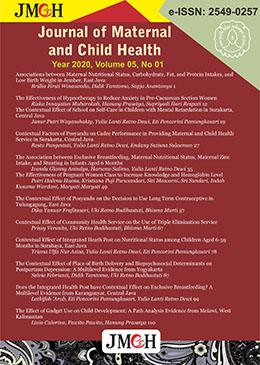The Contextual Effect of School on Self-Care in Children with Mental Retardation in Surakarta, Central Java
Abstract
Background: WHO analysis estimates the number of children with disabilities reaching 7-10% of the total population of children. The limitations of retarded children are influenced by age, physical condition, nutritional status of the child, and parenting in the family have a relationship in the level of independence of the children. The purpose of this study was to analyze the factors that influence self-care in retarded children in Surakarta, Central Java.
Subjects and Method: This study was a cross sectional study conducted in 15 special schools in Surakarta, Central Java, from June to July 2019. A sample of 200 mentally retarded children aged 9-17 years was selected by stratified random sampling. The dependent variable was self care. The independent variables were age, nutritional status, mental retardation classification, maternal age, maternal education, maternal occupation, maternal knowledge, parenting style, and teacher sup
and mothers based on family pediatrics: report of the task force on the family. Syifa Medika, 7(2): 45-55. doi: 10.32502/sm.v7i1.1395 [Crossref] [Google Scholar] 10.1007/s10803-015-2561-z [Crossref] [PubMed] [Google Scholar]
How to Cite
References
Astuti FD, Salimo H, Pamungkasari EP (2018). Factors associated with the risk of autism in children under five years of age: a path analysis evidence from Banten. J Matern Child Health, 3(4): 278
Ekaete R, Arikpo M, Chukwudi NEOM, John J, Agbu M (2015). Mentally retarded children and deficits in daily living skills: case study of calabar municipality local government area, cross river state, Nigeria. IOSR-JRME, 5(2): 2320
Fikriyyah S, Adriani RB, Murti B (2018). What are the factors that affect the risk of parenting stress in mothers with disability children? A new evidence from Sukoharjo. J Matern Child Health, 3(2): 156
Gilson CB, Bethune LK, Carter EW, Mc-Millan ED (2017). Informing and equipping parents of people with intellectual and developmental disabilities. Intellectual and Developmental Disabilities, 55(5): 347
Groce N, Challenger E, Berman-Bieler R, Farkas A, Yilmaz N, Schultink W, Kerac M (2014). Malnutrition and disability: Unexplored opportunities for collaboration. Pediatr Int Child H, 34(4): 308
Haris A, Haris A (2019). Improvement of mother knowledge who have children age 2-5 years about training toilet using a drawing media. Int J Nurs Stud, 4(2): 76
Huang J, Zhu T, Qu Y, Mu D (2016). Prenatal, perinatal and neonatal risk factors for intellectual disability: a systemic review and meta-analysis. PLoS ONE, 11(4): 1
Kemenkes RI (2014). The situation of persons with disabilities. Jakarta: Kementerian Kesehatan RI. [Website]
Kemenkes RI (2018). Healthy portrait of Indonesia from Basic Health Research in 2018. [Website]
Ma'mun A, Prameswarie T (2016). The relationship between family parenting with parenting stress on parents of mentally retarded children at the Foundation for the Coaching of disabled children Palembang family introduction especially fathers
Machalicek W, Lang R, Raulston TJ (2015). Training parents of children with intellectual disabilities: Trends, issues, and future directions. Curr Dev Disord Rep 2:110
Magiati I, Tay XW, Howlin P (2014). Cognitive, language, social and behavioral outcomes in adults with autism spectrum disorders: a systematic review of longitudinal follow-up studies in adulthood.Clin Psychol Revi, 34(1): 78
Perry-Jenkins M, Laws HB, Sayer KNA (2019). Parents work and children
Mardiawati D (2019). The relationship between knowledge and parent care patterns with mental retardation children ability in self-care. Journal Endurance, 4(1): 34
Mlinac ME, Feng MC (2016). Assessment of activities of daily living, self-care, and independence. Arch Clin Neuropsych, 31(6): 506
Na
Nogay N (2013). Nutritional status in mentally disabled children and adolescents: A study from Western Turkey. Pak J Med Sci, 29(2): 614
Onis MD (2017). Child growth and development in Nutrition and Health in Developing Countries: 71-91. [Website]
Peer JW, Hillman SB (2014). Stress and resilience for parents of children with intellectual and developmental disabilities: A review of key factors and recommendations for practitioners. J Pol Pract Intellect Disabil, 11(2): 92
Pieter HZ (2017). The basics of communication for nurses. Jakarta: Kencana.
Ramadhani AN, Adriani RB, Salimo H (2018). Path analysis on the bio psychosocial determinants of quality of life among children with cerebral palsy. J Matern Child Health, 3(4): 301
Ramawati D, Allenidekania A, Besral B (2012). The ability to care for mentally retarded children based on external and internal factors of the children. Jurnal Keperawatan Indonesia 15(2): 89-96. doi: 10.7454/jki.v15i2.32 [Crossref] [Google Scholar]
Woodman AC, Smith LE, Greenberg JS, Mailick MR (2016). Contextual factors predict patterns of change in functioning over 10 years among adolescents and adults with autism spectrum disorders. J Autism Dev Disord Title, 46(1): 176










